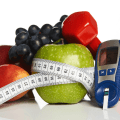Table of Contents
How to monitor your glucose? Most of the treatment and prevention schemes are largely self-managed but definitely manageable. Monitoring of the blood glucose levels is an individual’s full-time job which he/she shares with his/her immediate family or caretaker. A lot of new information and tasks will be integrated to your normal daily routine; and there’s no question that things can be very overwhelming at the beginning.
How to monitor your glucose? You should remember that this is the only way to a healthier lifestyle. Nothing can happen without a change and if that change determines the quality of your life; then I believe you’re willing to make that change to live a healthy life – free from diseases. Carbohydrates are the primary food type that raises blood sugar/has the most marked effect on it. As such, it is paramount that you pay a lot of attention to the carbs; that you consume and be very careful not to eat the wrong type of carbs. In this article, you’ll learn how to monitor your glucose?
Measuring Your Blood Sugar Levels
How to monitor your glucose? You can measure your blood sugar level by measuring the glucose level. Your glucose level refers to how fast a serving of a particular food raises the blood sugar level; as compared to glucose and white bread. Foods are considered to be very low, low, medium, or high sugar. Foods with low glucose are those that cause minimal rise in blood sugar within 2 hours after eating.
High glucose foods are those that give the greatest increase in blood sugar levels. High fiber foods with complex carbohydrates have a low glucose. Examples are bread, cereals and rice that are whole-grain. However, just because foods have a low glucose doesn’t mean that they are healthy. Glucose refers only to the carbohydrate content. Protein and fats do not contain carbohydrates, hence are low glucose foods. Eating a lot of these can also be harmful to health. Maintain balance in the calories and portion control of all foods.
How to monitor your glucose? Most very low glucose foods are vegetables that are dark green and leafy. Fruits range from low to medium glucose. Nuts and seeds range from very low glucose to low glucose. Soybeans and tofu are very low glucose foods. Other types of beans are low glucose foods. Protein-rich foods are all very low glucose because they do not contain carbohydrates. However, eat in moderation because they can harm the body if taken in huge amounts. Dairy products are low glucose foods.
Adjusting Glucose Levels
How to monitor your glucose? Glucose levels are used to calibrate the impact that a carbohydrate has on blood sugar. This is why foods that have a low glycemic load/index have the effect of only raising blood sugar modestly, and are for this reason, a superior choice for Type 2 Diabetes patients. In general, the main factors that have the biggest effect on a meal’s glycemic load are carbs, fiber, fat and protein amount present. This is especially the case when you are dealing with simple carbs, as opposed to complex carbs – if the carb amount is high, the glycemic load will be high.
Foods that Can Help Maintain Blood Glucose
Garlic
How to monitor your glucose? It is a bulbous perennial herb that grows up to 4 ft. in height. It produces hermaphrodite flowers. Allicin, a sulfur-containing compound is responsible for its pungent odor and it has been shown to have significant hypoglycemic activity. Several other researches including studies on effect of garlic extract on blood glucose levels and lipid profiles in streptozotocin/alloxan – induced diabetic rats, alloxan diabetic rabbits have exhibited its antidiabetic activity. Apart from this, Garlic exhibits antimicrobial, anticancer and cardio protective activities also.
Cinnamon
Cinnamon is a spice obtained from the inner bark of several trees from the genus Cinnamomum. The most active compound in cinnamon, known as methylhydroxy chalcone polymer; mimics insulin increases glucose metabolism and effectively lowers blood glucose levels. Cinnamon also reduces serum triglycerides, LDL cholesterol, and total cholesterol.
Indian Kino
It is also known as Vijayasar, Indian Kino, Benga, Bijiayasal, Piasal, Venkai to name a few. It is a deciduous moderate to large tree that can grow up to 30 meters tall found in India mainly in hilly region. Pterostilbene, a constituent derived from wood shows hypoglycemic activity because of presence of tannates in the extract. Epicatechin, its active principle, has been found to be insulinogenic, enhancing insulin release and conversion of proinsulin to insulin in vitro.
Ginseng
How to monitor your glucose? Ginseng is a slow-growing perennial plant with fleshy roots, belonging to the genus of the family Araliaceae. Root of Asian ginseng is useful in reducing the level of glucose in the blood. It has the ability to enhance the release of insulin from the pancreas and increase the number of insulin receptors. In clinical studies, Asian ginseng has demonstrated a direct blood-sugar lowering affect.
Ginseng contains a family of steroid-like compounds called ginsenosides. Some ginseng compounds show contradictory effects. This syndrome consisted of hypertension, nervousness, sleeplessness, skin eruptions, increased libido, and morning diarrhea. The most commonly reported side effects include nervousness and excitation. Other effects include headache, hypertension, insomnia, and estrogenic effects.
Blueberry
How to monitor your glucose? It is a low – growing shrub belonging to the genus Vaccinium (family Ericaceae), bearing edible, nearly black berries. They are closely related to the European bilberry. There are several species of blueberries exist- including V. pallidum and V. corymbosum and grow throughout the United States. Blueberry is a natural method of controlling or lowering blood sugar levels the leaves have an active ingredient with a remarkable ability to get rid the body of excessive sugar in the blood. It is a good astringent and helps relieve inflammation of the kidney, bladder and prostate.
Tips on Managing Your Glucose
Tip #1
How to monitor your glucose? Meds for diabetics can be administered either orally or by injection. Insulin and hypoglycemic drugs are the primary drugs utilized by diabetic patients.
Tip #2
Some individuals in severe diabetic stages suffer from kidney failure, which will require regular dialysis. Some others opt for the more expensive and complex surgical procedures, specifically kidney and/or pancreas transplants. Physicians recommend implantation of pancreatic cells as an alternative in order to eliminate transplant rejection.
Tip #3
How to monitor your glucose? The Diabetes Control and Complications Trials stated that a well-devised; anti-diabetes diet plan can significantly reduce the levels of glycosylated hemoglobin in the blood by at least 1%; which is equivalent to more than 25% decrease in degree of severity of diabetic complications, including diabetic nephropathy, retinopathy; and neuropathy.
Tip #4
A physically taxing activity requires a sufficient amount of energy, and the body works to answer this demand by burning calories and converting food; specifically the glucose units in the blood, into energy. With the help of your doctor, devise an exercise routine and schedule that’s applicable for you.
Diabetics are required to exercise with the same amount of time and intensity every day to avoid further aggravation of their condition. Please remember that hypoglycemia; or drastic drop in blood glucose levels can occur during and/or after moderate exercises, hence insulin intake; and/or ingestion of a carb snack is suggested. Remember to drink lots of fluids during and after exercise.
Tip #5
How to monitor your glucose? Medical procedures, balanced diet; and exercise cannot be thoroughly effective in fighting off illnesses without the practice of healthy lifestyle and habits. Practice moderation when eating and meditate at least 20 minutes a day. Remember to get enough sleep every day, and drive away stress as much as you can.
Tip #6
SBMG is a self-performed method of monitoring hyperglycemia and hypoglycemia, which involves reading glucose levels from a blood sample that’s applied on a strip and analyzed by a blood glucose meter for 5 – 30 seconds. Any abnormal result will immediately prompt the individual to seek clinical help to prevent further complications.
Tip #7
How to monitor your glucose? The person suffering from diabetes; and his/her immediate family should have knowledge about the nature of diabetes, the probable cause of the disease (hereditary or due to unhealthy lifestyle); and the immediate countermeasures or first aid methods that should be performed in case of an emergency.
Tip #8
Complex carbs are the carbs you should primarily focus on; since they are low glycemic load carbs that are in their ‘whole food’ form, or otherwise unprocessed, and are inclusive of additional nutrients such as vitamins, fiber and small amounts of fats and proteins. They come whole, and no ‘separations’ or ‘extractions’ – all factors of industrial processing.
Tip #9
Whole grains such as oatmeal, quinoa and brown rice are great sources of nutrients and fiber. They have a low glycemic load, and this makes them great food choices. Ensure that you have these in your diet. They are also lower in carbohydrates than refined grains. You can eat these in moderation. Try to eat these in smaller portions of one cup; preferably as part of a combination meal that is inclusive of plant-based fats and protein.
Tip #10
How to monitor your glucose? Make sure to eat green vegetables. Feel free to eat these in abundance – they will not spike your blood sugar levels even if you gorge on them. What is more, they have a low caloric content; which means you can eat lots of them without worrying about piling on body fat. Eating fresh green vegetables is your best option. However, if this is difficult, ensure that there are no sweeteners added. If you do not like them on their own, prepare them with fresh/dried herbs, a vinaigrette dressing or olive oil.






 I love to write medical education books. My books are written for everyone in an easy to read and understandable style.
I love to write medical education books. My books are written for everyone in an easy to read and understandable style.